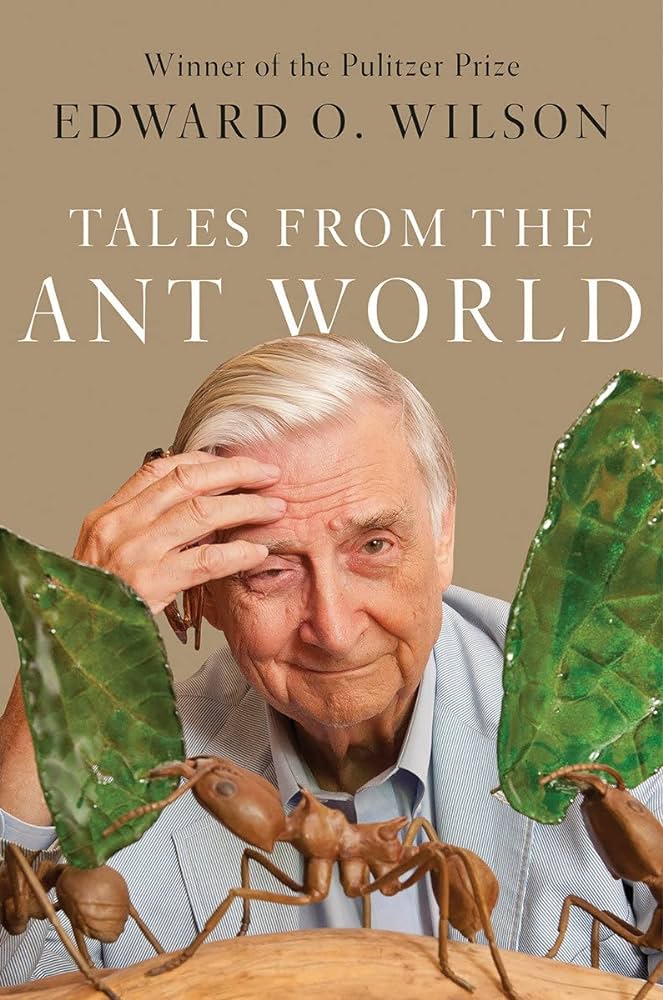Tales from the Ant World by E. O. Wilson

As a kid growing up in the Soviet Union, I remember eyeing a book called Пароль скрещенных антенн (literally "password of the crossed antennae") on my grandfather's bookshelf. It had a green leather home-made cover on it with just the title on it in block capital lettering. My grandfather bound it himself, as he did with many other books, from popular science books to books banned by the authorities. Grandma told me many stories about his obsession with books and bookbinding hobby which he took on after retirement. He would read everywhere: on the pot, at the dinner table, on the sofa. He always had a book on his person, which came in handy because Soviet life involved waiting in so many long queues, you could get a lot of reading done.
I still have the book, and it's on my to-read shelf, but for now, I opted for E. O. Wilson's most accessible take about ants to whet my appetite. "Tales from the Ant World" is a sort of popularization of his more famous "Ants", a Pulitzer prize winning textbook. This in itself is remarkable, but E. O. Wilson is also a pretty remarkable figure who I first learned about from his work on consilience. The writing in "Tales" is very personal, including many anecdotes from Wilson's life, and I think is geared to nudge younger readers towards myrmecology when they grow up. Perhaps less specifically, this book feels primed to maximize latent curiosity for budding scientists (it me?).
Overall it was well written and crazy interesting, a nice diversion from my usual topics. As it happens, I'm dealing with a minor ant infestation at home. There's something pleasantly escapist about peeling back a mundane aspect of our daily experience and discovering a whole world inside. It's equally real, but completely different.
Reproduction
- The vast majority of useful ants (workers, soldiers, queens) are female.
- Males are "little more than flying sperm missiles", who after their nuptial flight, die or are driven away by their sisters
- Winged ant queens can be inseminated by multiple males and have provisions for storing male sperm for the duration of their whole lifetime, 10 to 15 years!
- A single queen is usually the mother of all the other ants in that colony.
Pheromones
- Ants can "speak" with a limited vocabulary 10-20 chemical "words". For example, a scout can discover food and report it to her sisters via pheromones she leaves on the trail behind her.
- Each ant colony has its own unique smell, allowing ants to differentiate members of their own colony from intruders.
- Dead ants emit a certain pheromone, and when they do, their sisters bring them to the ant cemetery.
- Wilson experimented by dabbing living ants with that pheromone and sure enough if dabbed, these ants are also carried to the cemetery despite their protestation! No ants were harmed in this particular experiment though. Subjects eventually wash themselves of it and return to normal ant life.
Violence
- Ants are the dominant carnivores in their weight class.
- Many ants are cannibals, eating their dead and injured.
- Some species of ants can enslave other species of ants, and this is most commonly done by raiding another colony and stealing the larvae. These then grow up in the slaver nest and become pheromonically synchronized with their captors.
- Wilson suggests this may be a good strategy of expanding worker ranks in a very difficult survival environment.
Super-organisms?
- Fire ants have a fascinating survival tactic for flooding. They cling onto one another and create a living raft to float an entire colony back to shore (check out this video).
- More accurately, it is a partially living raft given that many of the lower layers of ants will die of asphyxiation for their sisters.
- Leaf cutter ants are especially coherent and work as a single unit.
- At which point are a collection of individuals better understood as a Super-organism?